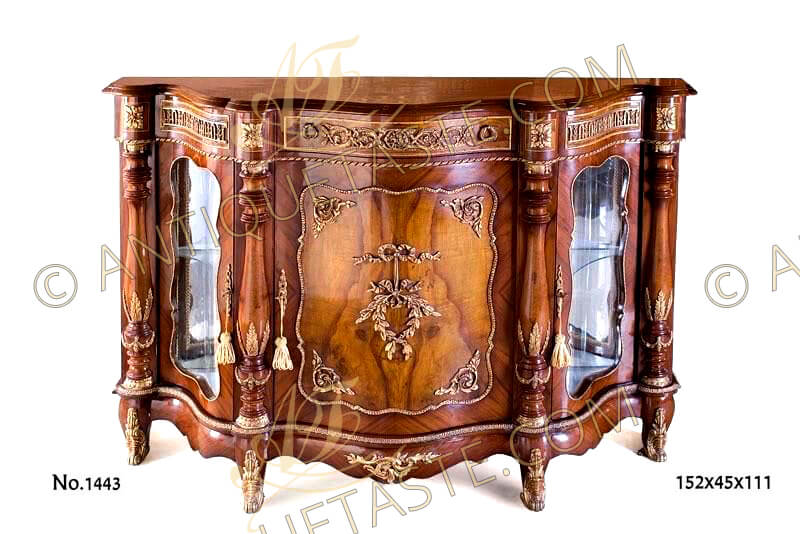Ref#C-1443 | Description
A robust French Napoléon III style distressed ormolu mounted sans-traverse veneer inlaid serpentine shaped display cabinet,
The veneered moulded top above a frieze with central drawer ormolu decorated with Rinceau Guilloche design and two lyre shaped handles, on each side a faux drawer ornate with Lead-and-dart ormolu design; the section has four circular block adorned with large ormolu rosettes, and each is above long Baluster with repeated Astragals on top and bottom ormolu-mounted with leaves on the belly and swaging garlands on the Torus; the Abacus and the plinth ormolu surrounded as well. Between the balusters to each side a display ormolu bordered glass door; The central balusters flanking a central sans traverse veneer inlaid door ornamented with beaded ormolu frame surrounding corner acanthus volutes around a central intricate and finely chiseled ormolu mount of knotted ribbons hanging a swaging foliate imbricated Laurus Nobilis,
The lower arbalest shape frieze is topped with an ormolu Leaf-and-Dart trim, centered with ormolu pierced C scrolled acanthus volute and raised on four short cabriole legs ornamented with acanthus ormolu sabots.
Ref#C-1443
152 x 45 x 111cm
The Napoleon III style:
The Napoleon III style is the name commonly given to a 19th-century style of Renaissance Revival architecture in France, especially in Paris. It is a sub-style of Second Empire architecture, which is a term also used elsewhere in the world for this style. It is characterized by its eclecticism, because of the mix of decorative elements from the past. It flourished during the Second French Empire, with the patronage of Napoleon III.
The term "Napoleon III style" (French: style Napoléon III) may be contemporary: legend has it that when the Empress Eugénie asked architect Charles Garnier whether the Palais Garnier, under construction in 1862, would be built in the Greek or Roman style, he replied, "It is in the Napoleon III style, Madame!" The term is also not reserved exclusively for architecture. It is used also to describe furniture of the period, especially in the marketplace, where other "royal period" styles are commonplace.
The style is characterised by high façades, mansard roofs, and, more rarely, pavilions. The buildings are richly decorated but with clearly defined outlines. The Napoleon III style is associated with the renovation of Paris under Baron Haussmann between 1852 and 1870. The buildings of the renovation show a singularity of purpose and design, a consistency of urban planning that was unusual for the period. Numerous public edifices: railway stations, the tribunal de commerce, and the Palais Garnier were constructed in the style.
Tags
- #Napoleon_III_Display_Cabinet | #Napoleon-III-China_Sideboard | #Napoleon-III-Credenza | #Second-Empire-Napoleon-III-Sideboard | #Ormolu-mounted-Napoleon-III-style-Credenza | #French-Louis XVI-Sideboard | #Parquetry-and-Marquetry-Bahut | #French-Bahut | #Japanese-lacquer-and-ebony-Sideboard | #Japanese-Black-small-Buffet | #Jean-Henri-Riesener-Bahut | #Empire-Style-Cabinet | #Napoleon-Style-Sideboard | #Napoleon-Second-Empire-Furniture | #Francois-Linke-Display-Cabinet | #Leon-Message-ormolu-design | #Haentges-Frères-Commode | #French-style-Cartonnier | #French-style-Cupboard | #French-Bombe-Commode | #19th Century Transitional style Commode | #Jean-François Leleu Commode | #Napoleon III Commode | #Napoleon III style Cabinet | #Napoleon III Side Cabinet | #Napoleon III Sideboard | #Meuble A Hauteaur D'appui | #Commode a vantaux | #Antoine Gaudreaux Commode | #Jean-Henri Riesener commode | #Marie-Antoinette commode | #Charles Cressent commode | #Maison Millet commode | #Pierre Antoine Foullet commode | #André Charles Boulle commode | #French style commode | #Louis XV commode | #Louis XIV commode | #Louis XVI commode

